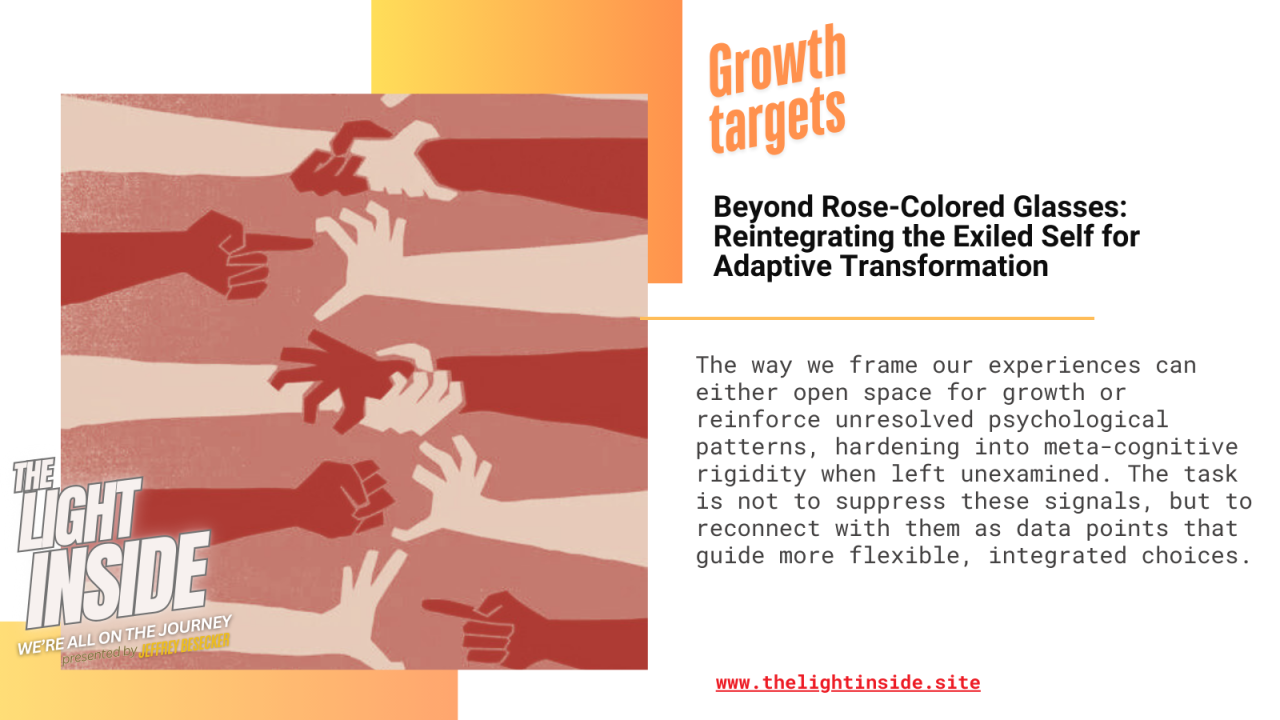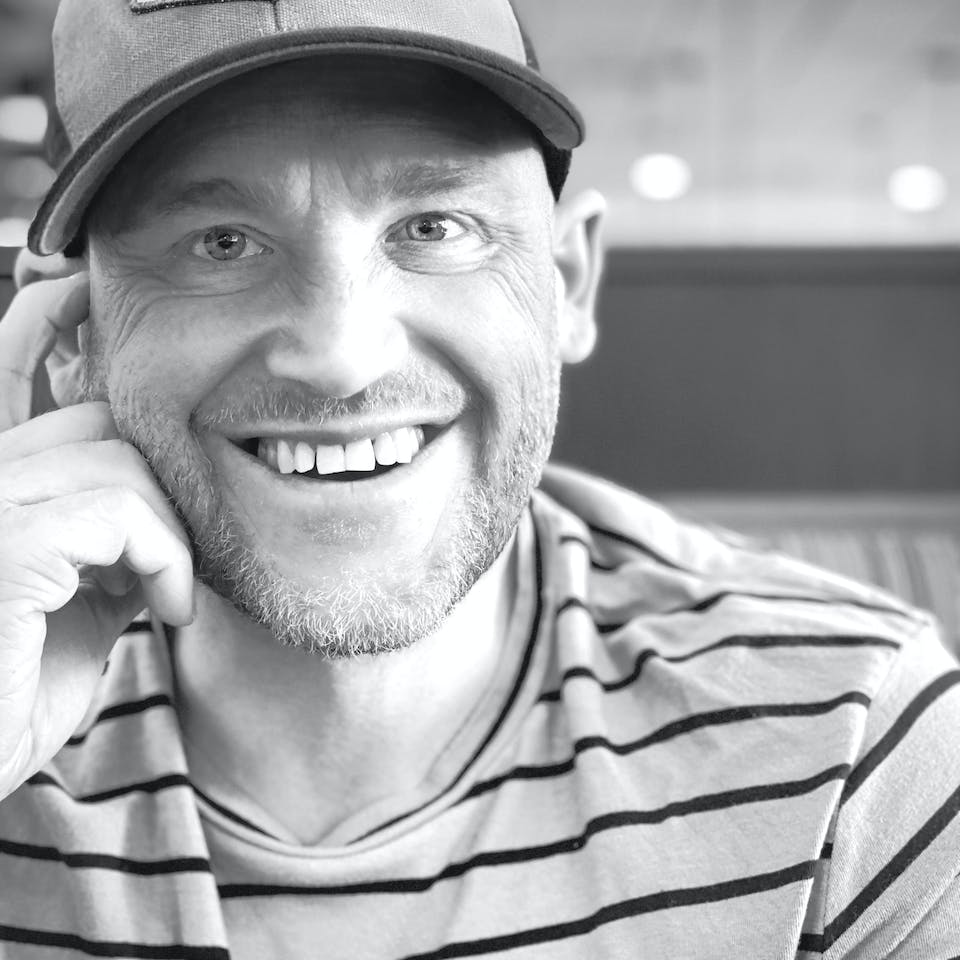Beyond Rose-Colored Glasses: Reintegrating the Exiled Self for Adaptive Transformation

What if the dissonance you feel—the tension between what you “know” and what you sense—arises not from weakness, but from unconscious heuristics that bias you away from seeing the hidden value in fatalism?
Yes—certain parts of you want to consider the possibility of your inevitable demise.
When unresolved psychological data lingers beneath awareness, it often distorts the way we forecast outcomes, nudging us toward either overly fatalistic or overly optimistic framings. By recognizing these misattunements, we can begin to reintegrate the signals as adaptive guides rather than letting them silently skew our choices?
So much of what drives our decisions isn’t what we consciously see, but the unresolved data beneath the surface.
When those hidden parts misalign, they can skew our forecasts—pushing us toward either doom-laden fatalism or rose-colored optimism—yet when we learn to reintegrate their signals, they become adaptive guides that ground us in wiser choices.
How might your own hidden signals—those quiet pulls of doubt or hope—be shaping the way you weigh risk, possibility, and choice?
At times, our exiled parts act as sentinels, pressing us to forecast limits, hedge against risks, and confront uncertainty with caution.
While optimism urges growth, this more sobering stance can calibrate our reach and prevent inhumility or overconfidence.
The paradox is that compassion for these parts, if framed through absolutist positivity, risks turning warnings into promises—blunting their adaptive function. Yet, when we integrate their signals, we gain a benchmark that grounds expansion in adaptive realism.
Hedging us to surrender our rigid ‘truisms’ for a more adaptive and responsive unity of opposites—whereby, both perspectives can hold a grain of truth.
- How might strengthening somatic coherence and attuning to the emotional valence of these signals expand our capacity to weigh not just uplifting stories, but also the counter-metrics that safeguard wise action?
A Counter-Argument (thesis)
“Exiled” parts don’t only need warmth and welcome; they can also function as a fatalistic sentinel. By dwelling on fragility and limit, they set conservative priorsthat adaptively bound our outer reach.
Mechanistically, they do this through (a) affective forecasting that weights loss more than gain, (b) heuristic shortcuts (negativity bias, error-management, defensive pessimism) that hedge against ruin, and (c) an implicit gauge of meta-cognitive dissonance—when our felt knowing diverges from our stated knowing, the “exile” amplifies discomfort or recalcitrance with uncertainty serving as a vagal brake (neural imprinting) not a confabulated construct and subjective flaw.
The result is better calibration (fewer overconfident bets), not mere self-sabotage.
Empirically aligned anchors: affective-forecasting errors and impact bias (Gilbert & Wilson), defensive pessimism as performance protection (Norem & Cantor), error-management theory (Haselton), intolerance of uncertainty as risk signal (IUS research), and optimism bias (Sharot). Philosophically, this treats the exile as a tragic rationalist—a part that preserves optionality by privileging adaptive limits, rather than an absolutist dismissal of them.
Value-reasoning structure (showing the contradictory reframing)
Core values → Epistemic stance → Inference rule → Policy → Outcome → Feedback
Harm-reduction & dignity of limits
→ Fallibilism under uncertainty
→ “Weight tail risks; treat confidence as hypothesis”
→ Pre-mortems, base-rate priors, small reversible steps
→ Fewer catastrophic errors; slower but stabler gains (metaphorically; eating the elephant)
→ Dissonance drops because action matches uncertainty.
(IFS-consistent)
→ (Risk) If turned into epistemic absolutism: “All parts are protective, therefore good → trust the uplift”
→ “Reframe every aversive signal as growth”
→ Over-positive forecasts; premature exposure; goal inflation
→ Short-term relief of dissonance, long-term miscalibration
→ Signals from exile get stigmatized, data are reinterpreted to fit hope.
The contradiction: the same “compassion” that softens inner conflict can collapse into epistemic absolutism, converting warnings into ‘narratives’ (subconscious scripts) of guaranteed benefit—a toxic or maladaptive positivity overfit that ignores base rates and uncertainty.
- The paradox of the negativity bias is that a positivity bias also exists simultaneously.
Therefore, the goal isn’t to eliminate these metrics, but to realign and reintegrate them when they drift out of tune with possible outcomes.
Practical guardrails (keep the exile adaptive)
Signal vs. Story vs. Strategy (3-column check):
- What is the raw signal (physiology/affect)?
- What story am I confabulating or constructing?
- What low-cost strategy respects the signal without suppressing or capitulating to it (acquiescence)?
Calibration loops: Brier-score your 30-day predictions; shrink/expand goals based on forecast accuracy.
Uncertainty budget: Pre-declare what amount of ambiguity is acceptable before pausing/escalating.
Pre-mortem + base-rate primer: Write the failure memo in advance; anchor to outside-view statistics before inside-view hopes.
Dissonance meter: When felt-sense ≠ stated conviction, slow the policy, rather than ‘sweeten’ or conflate the story (subconscious scripts, the introspection illusion, delusion; e.g. ‘super powers’)
Bottom line: welcoming the exile is necessary, but letting it model worst-case boundaries is often adaptive. Compassion should widen perspective, not harden into absolutist optimism that converts every ‘red flag’ into a growth tale.
Some stories are meant to bring our attention to our inherent shortcomings—my friends; that is adaptive evolution.
The harder truths we often suppress or try to outrun by confabulating a ‘bigger’ narrative, rather than admitting our vulnerability, and shortcomings.
Ultimately, the way we frame our experiences can either open space for growth or reinforce unresolved psychological patterns, hardening into meta-cognitive rigidity when left unexamined. The task is not to suppress these signals, but to reconnect with them as data points that guide more flexible, integrated choices.
Coachable Inquiry & Call to Action
What stories might your framing be reinforcing, and how could those narratives be quietly cementing old patterns rather than freeing you from them?
This week, try pausing when dissonance arises—notice the signal in your body, name the story you’re telling, and ask: how can I reintegrate this data to create a more balanced perspective?


